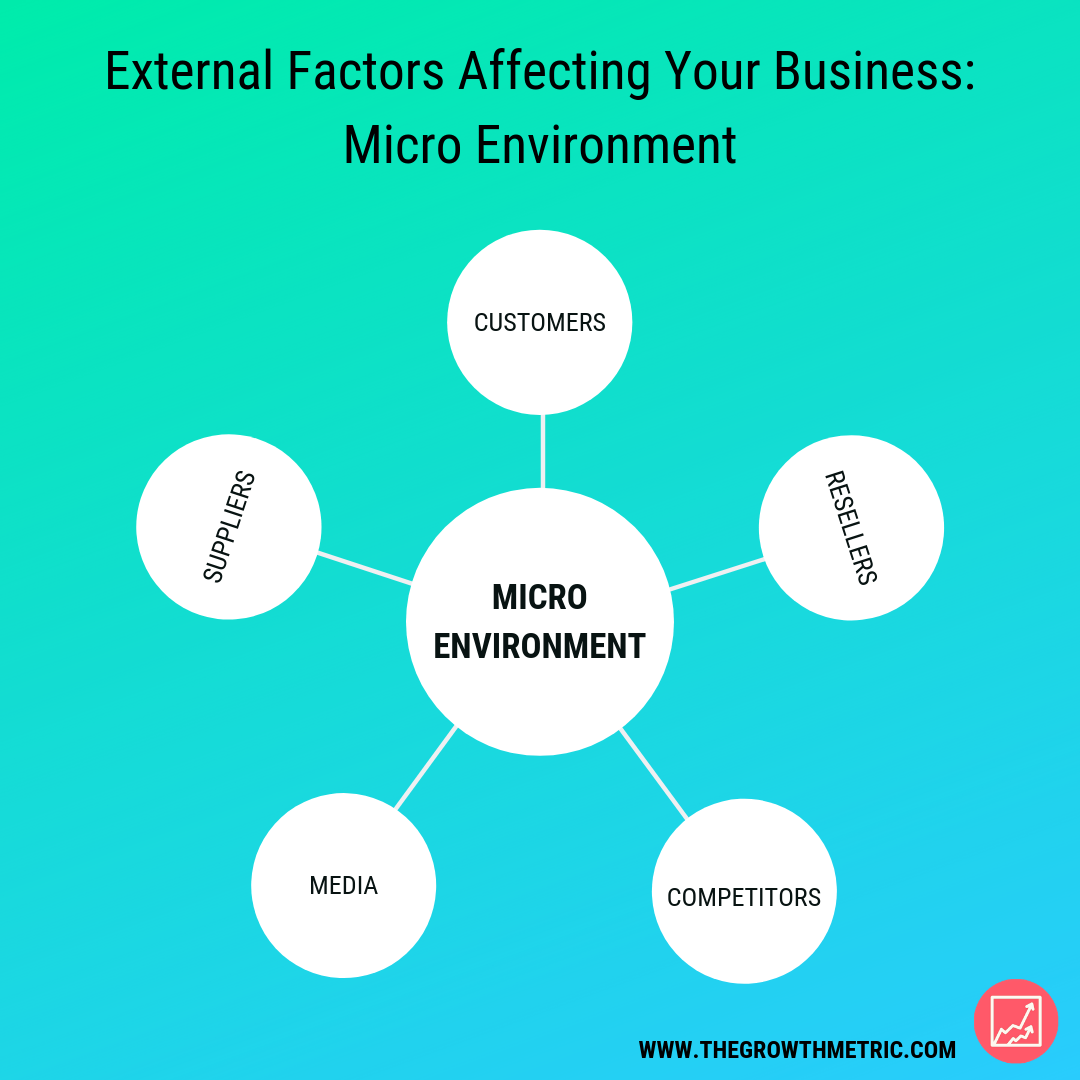
To understand external factors affecting your business, specifically the micro environment factors affecting your business, you need to accept that the market is constantly changing.
For you to adapt to the market change and your customer’s need, you need to analyze and understand your business environment.
Every business is affected by the internal and external environment in which it operates in.
Internal factors affecting your business could be:
- Your staff
- Your product or service offering
- Financial resources
- Physical resources
- Company culture, etc.
Likewise there are several external affecting your business such as:
- Your suppliers
- Your competitors
- Your customers
- Media
- Politics
- New technology
- New Legislation that can affect your business etc.
The external factors affecting your business can be grouped into two categories.
Micro environment factors and Macro environment factors.
You can think of your business micro environment as the immediate external factors affecting your business, these are factors you have some control over.
Related Post: How To Analyze Your Business Standing In the Market (SWOT)
5 Micro Environment Factors Affecting Your Business
Now that you know what micro environmental factors are, it’s time to put in the context of your business.
Before reading further, take a minute to think about the external factors affecting your businesses that you have some level of control over.
What Micro environmental factors did you come up with?
You probably listed factors such as customers, media, and suppliers (They were listed earlier for a reason). Take another minute to really think about how you can control these micro environmental factors to grow your business.

1. Customers
The Customers are the core of every business, you could say the business revolves around the customer, as without them, the business would not last long in the market.
This is why businesses adopt strategies to help attract and retain customers.
Who your customers are whether local or international, B2B or B2C, and their reasons for buying your product or service plays a large role in how you approach the marketing of your products or services to them.
The true fact is that customers have the most economic impact on a business. They are the biggest external factor affecting your business.
2. Suppliers
A supplier is a person or a business that provides products to services to other companies as one of the contributors to the development process of the final product/service.
They are often the intermediary between the manufacturer and the retailer or distributor.
A supplier can control the success of a business if they are the only or the largest suppliers of the product/service a business relies on. This means they can control the price and availability of resources valuable to your business.
3. Resellers
A reseller is a person or business that buys products or services with the intention of selling them to another an individual or company, rather than using them.
For IT products and services, a reseller acts an intermediary between the company that produces/provides/distribute the product or service, and the end user.
A reseller, can also be a “vendor” that purchases products at wholesale prices and sells the product at retail prices to the end user.
A reseller can shape the way your business is perceived and can either improve or damage your business reputation.
For example, if a customer has a favorable or unfavorable experience with one of your company’s official resellers, a positive experience can be leveraged when marketing the product.
On the other hand, the negative experience would not only reshape the way the customers think about your company, but also the way potential customers would see your company.
4. Competitors
No matter what product or service your offer, there is always going to be someone offering a similar and product/service.
Your competitors play a key role in creating and executing business strategies.
There are two types of competitors: Direct competitors and Indirect competitors.
Direct Competitors are business who’s core offering is similar to yours.
Indirect Competitors are businesses who offer a substitute product or service. For example, Weetabix competitors include not only makers of cereal but also other alternative breakfast options.
Both types of competitors can affect your business external environment, so you need to take into consideration how their price and product differentiation impact your business.
The level of competition you have in your market can also affect your business financials, as theoretically, more competitors means your share of dollars customers spend declines.
However, a lot of competitors in your market, means that there is a high demand for the products or services provided.
5. Media & The General Public
Contrary to the saying “Any press is good press,” the media can make or break your business reputation.
You should strive to maintain a good relationship with the media, as whatever it shows, whether on blog posts, news articles, social media etc. can affect your business operation.
The way you reach and connect with your customers and the general can also have a positive brand image in your public’s mind.
You also need to consider every public (and sometimes private) action your company takes from the angle of the general public.
Think about it, if the public can help you reach your business goals, then they can also prevent you from reaching those same goals.
Lastly, you should consider the role your local community plays in affecting your business whether positively or negatively.
Most communities often support companies that provide jobs, pays taxes, contribute to the community’s development and operate with social and environmental responsibility.
This sadly means that if you do not do this, not only would you not get a positive community support, you might actually get some negative backlash from the public.
How To Use Micro Environmental Factors To Grow Your Business
Now that you know the micro environmental factors affecting your business, it’s time to use this to generate marketing strategies that can help improve your company’s position within your market.
Previously, we talked about how to Analyze your business standing in the market using SWOT Analysis the same thing applies here.
To recap, A SWOT analysis is a list of your business internal strengths and weaknesses, and external opportunities and threats.
SWOT Analysis stands for Strengths, Weaknesses, Opportunities and Threats Analysis.
For each of the five Micro Environmental factors, analyze where your business stands in terms of your strengths, weaknesses, available opportunities and threats.
We will discuss the macro environmental factors affecting your business next.
